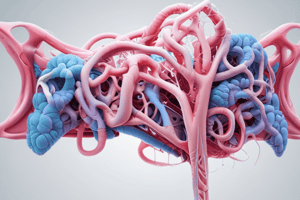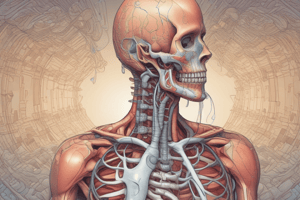Podcast
Questions and Answers
List the pathway or air orderly
List the pathway or air orderly
Nasal/oral cavity > pharynx > trachea> primary bronchi> secondary bronchi> tertiary bronchi >bronchioles >alveoli
Where is the site of gas exchange
Where is the site of gas exchange
Alveoli
What are the phases of respiration
What are the phases of respiration
Inspiration and expiration
What phase of respiratory is a active process
What phase of respiratory is a active process
What phase of respiratory is a passive process
What phase of respiratory is a passive process
List the respiratory units
List the respiratory units
What is pulmonary function test
What is pulmonary function test
What is the pulmonary function test based on
What is the pulmonary function test based on
What is used to carry out the pulmonary function test
What is used to carry out the pulmonary function test
What is static lung volume
What is static lung volume
List the examples of static lung volumes
List the examples of static lung volumes
What is tidal volume
What is tidal volume
What is inspiratory reserve volume
What is inspiratory reserve volume
What is expiratory reserve volume
What is expiratory reserve volume
What is residual volume
What is residual volume
What is static lung capacity
What is static lung capacity
List the types of lung capacity
List the types of lung capacity
What is inspiratory capacity
What is inspiratory capacity
What is total lung capacity
What is total lung capacity
What is functional residual capacity
What is functional residual capacity
Flashcards
Pathway of Air
Pathway of Air
Orderly route air takes into the lungs: nasal cavity > pharynx > trachea > bronchi > bronchioles > alveoli.
Site of Gas Exchange
Site of Gas Exchange
Alveoli are the tiny air sacs where oxygen and carbon dioxide exchange occurs.
Phases of Respiration
Phases of Respiration
The two main phases are inspiration (breathing in) and expiration (breathing out).
Active Process of Respiration
Active Process of Respiration
Signup and view all the flashcards
Passive Process of Respiration
Passive Process of Respiration
Signup and view all the flashcards
Respiratory Units
Respiratory Units
Signup and view all the flashcards
Pulmonary Function Test
Pulmonary Function Test
Signup and view all the flashcards
Basis of Pulmonary Function Test
Basis of Pulmonary Function Test
Signup and view all the flashcards
Equipment for Pulmonary Function Test
Equipment for Pulmonary Function Test
Signup and view all the flashcards
Static Lung Volume
Static Lung Volume
Signup and view all the flashcards
Examples of Static Lung Volumes
Examples of Static Lung Volumes
Signup and view all the flashcards
Tidal Volume
Tidal Volume
Signup and view all the flashcards
Inspiratory Reserve Volume
Inspiratory Reserve Volume
Signup and view all the flashcards
Expiratory Reserve Volume
Expiratory Reserve Volume
Signup and view all the flashcards
Residual Volume
Residual Volume
Signup and view all the flashcards
Static Lung Capacity
Static Lung Capacity
Signup and view all the flashcards
Types of Lung Capacity
Types of Lung Capacity
Signup and view all the flashcards
Inspiratory Capacity
Inspiratory Capacity
Signup and view all the flashcards
Total Lung Capacity
Total Lung Capacity
Signup and view all the flashcards
Functional Residual Capacity
Functional Residual Capacity
Signup and view all the flashcards


